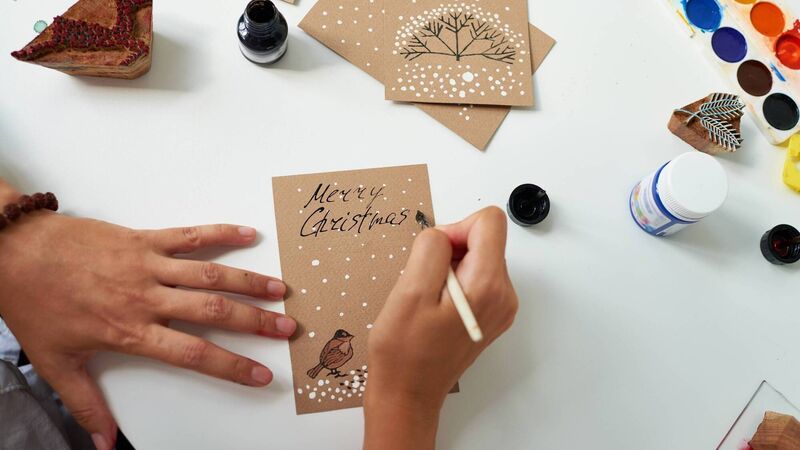Joyce Fegan: There’s something sacrosanct about Christmas cards

A handwritten Christmas card also has the effect of bringing you to your senses.
I pored over my mother's Christmas cards for hours. There'd be dozens of them. I was meticulous in my inspection. I loved the unusual ones, making sure to see who the sender of those were. I'd be unimpressed by the ones with the singular robin on the cover or the ones with the less stiff card.
I'd count how many matched, disappointed that not every card was unique. And I always read the messages inside, a bit annoyed when there was nothing but an illegible sign-off, why send a card if you're not even going to bother writing a note? And I'd be more than intrigued by the long elaborate letters on some, though they were rare. They came from nursing college friends of my mother or else a fella in Canada from my father's Dublin youth. I enquired as to who these people were, and in doing so, accidentally got to know my parents' better - discovering the people they were before they were parents.
A busy life gets in the way of staying in touch.
I'm now the age my mother was when I was rooting through her Christmas cards.
And I now pore over my own ones, no longer caring about the pictures on the front nor the word count in the middle, but trying to divine the love and care contained in one small envelope. Especially now.
In a world where you can fly off a message of a goodwill with the flick of your thumb on your channel of choice, WhatsApp, Facebook or old school text, there is something now sacrosanct about the Christmas card, especially the Covid Christmas card.
Someone went to the effort of searching for your postal address, maybe they asked you outright or perhaps they asked a friend. Someone went to the effort of affixing a stamp to an envelope and then, made their way to a post office in the busy month of December.
All of that is no mean feat in 2021, with so many easy alternatives and very big distractions at play.
Two of my cards came from old school friends. One is five days over on her second child, maybe she'll be a mother of two by the time these words find ink. And the other card came from someone who has stood at the frontline of our medical services for 22 months and counting. Another one came early, so elaborate it had its own pop-up moose - this sender is busy caring for her beloved husband, amongst other noble things.
As I pored over these cards, I realised I was just doing the same thing I did 30 years ago - appreciating official demonstrations of love between friends, only mine this time.
Thirty years ago I strung them all to red and green threads and hung them around French door frames. Today, I've only enough for one windowsill.
Our older generations never got corrupted by the technological revolution, nor did they let time poverty get in the way of sending handwritten goodwill.
It's ironic that the first postcard ever sent came out of time poverty, and now we are too time poor to even send them.
A Victorian celebrity named Henry Cole had too many friends and not enough time to get back to their handwritten Christmas letters, an old English custom. It was considered rude not to reply to every letter you received.
Cole's time poverty and popularity made him a bit anxious, so he approached an artist called JC Horsley to draw a picture of a merry and feasting family, even the kids were drinking wine, alongside images of the poor. The only words printed on the stiff card were "To" and “A Merry Christmas and A Happy New Year To You.”
He had 1,000 copies printed. The year was 1843. It was the first Christmas card ever sent. All of this was buoyed on by the fact that commoners could now send a card or letter for a penny, with the recent expansion of the British postal service. In Ireland, we got in on the act in the early 1900s.
For Christmas 2021, An Post reckons we'll be sending six million letters and parcels every day between now and December 22 (the cutoff date for packages going to Irish addresses). They usually handle two million a day. A quick call to the postal powers at be in the writing of this led to the fact that people are sending even more cards and parcels this year, in an effort to "reach out".
What a handwritten Christmas card in 2021 says is: "I thought of you, like really thought of you". It's the same feeling when you get an incredibly thoughtful gift, only better. Save for the cost of the card and the stamp, no one bankrupted themselves in their expression of love for you.
A handwritten Christmas card also has the effect of bringing you to your senses. I read a story on the New York Times this week, it was accompanied by their pictures of the year, think political division, babies crossing borders with only a nappy on, Afghans clambering to board planes and other horrors of our humanity.
Of course I can donate here and there, sign a petition and keep myself "informed" but mostly I just feel powerless in the face of our species' idiocracy. But my feelings of guilt and powerlessness are never of use to our fellow humans thrown into dire straits.
When I get a card I'm snapped out of it, reminded of the good fortune of friends - the gratitude obliterating any self pity and propelling me towards action for others, instead of languishing in powerlessness.
All that said, I have yet to send a single Christmas card and will instead be influenced by an old friend who made a donation to a refugee programme in lieu of sending cards.






